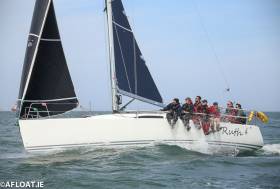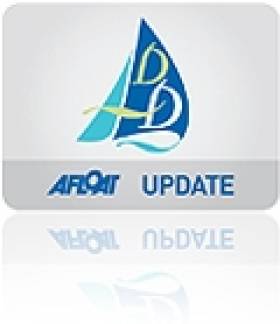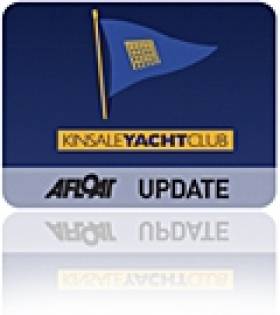Displaying items by tag: Ruth
The Dun Laoghaire to Dingle Race is now such a significant event that inevitably it attracts the involvement of professional and semi-professional talent. But so many boats sail determinedly within the Corinithian ideal that in effect they created an extra Division within the race. No boat better typified this than Dun Laoghaire’s Shanahan family with their J/109 Ruth, where they deferred to one of the youngest on board - 19-year-old Tom Shanahan - as skipper. He called the shots very well indeed, with Ruth taking over the lead in the J/109s at the Fastnet, and handling the tricky beat from there to the finish so well that they placed a close fourth overall in the total fleet, and clear Corinthian winners.
#d2drace – The results in the National YC's 280–mile 30–boat Dun Laoghaire to Dingle Race have now been officially ratified, and they confirm the Shanahan family's J/109 Ruth (National YC) as overall winner. The race has been a remarkable success for J/Boats, as top performing craft from the design board of American Rod Johnstone have taken five of the first six places.
In the Two-Handed Division, at Dingle Colm Buckley and Simon Knowles (Howth YC) had regained their initial lead – which they'd lost while battling light headwinds off the Kerry coast - and they finished well to place 12th overall with the Elan 340 Blue Eyes, thereby putting 16 fully-crewed boats astern. Just one place behind Blue Eyes in 13th overall was the defending champion from Tralee Bay SC, Brian O'Sullivan and Frances Clifford's Oyster 37 Amazing Grace, which won the Cruiser Division.
This weekend's Sailing on Saturday blog on Afloat.ie by W M Nixon will feature a profile of the Shanahan family and Ruth, together with a more detailed analysis of the race and the results.
Dun Laoghaire to Dingle Race 2015 (National YC & Dingle Sailing Club)
IRC Overall: 1st Ruth (J/109, B, W, A, T & P Shanahan, National YC) Corrected Time: 1 day 23hrs 30 minutes & 48 seconds; 2nd Mojito (J/109) Peter Dunlop & Vicky Cox, Pwllheli SC) 1:23:51:50; 3rd Aurelia (J/122, Chris & Patanne Power Smith, Royal St George YC) 2:0:15:52; 4th Dear Prudence (J/109, Jonathan Bourke, Manhattan YC) 2:1:18:14; 5th Alchimiste (JPK 9.60, Mike Murphy, National YC) 2:1:19:04; 6th Aquelina (J/122. James & Sheila Tyrrell, Arklow SC) 2:1:31:10
Two-handed Division: 1st Blue Eyes (Elan 340, Colm Buckley & Simon Knowles, Howth YC) 2:4:27:10; 2nd Joker (Sigma 38, David Gibbons, Kinsale YC) 2:7:24:19
Cruising: 1st Amazing Grace (Oyster 37, Brian O'Sullivan & Frances Clifford, Tralee Bay SC) 2:8:46:54; 2nd Yahtzee (Beneteau Oceanis 411, Richard Mossop, Dun Laoghaire Motor YC) 2:7:58:48; 3rd Lady Rowena (Sadler 34, David Bolger RStGYC) 2:8:41:10
Shanahan's 'Ruth' Crew Crowned ISORA Champions at National Yacht Club Prizegiving
#isora – ISORA held its annual prizegiving dinner dance at the NYC on Saturday 15th November. 171 members and guests packed into the dining room of the club to be treated to a superb night's dining and entertainment.
ISORA's guests at the event were Larry Power, Commodore of the National Yacht Club, Derek Matthews, Commodore of the Royal Dee Yacht Club and Barry MacNeaney, Commodore of the Royal Alfred Yacht Club.
The MC for the evening was Peter Ryan, Chairman of ISORA, who directed the traditional toasts made by each of the guests and Andrew Hall, past Chairman of ISORA. Due to the numbers of people in the dining room the Royal Navy tradition of not standing for the Loyal Toast to the "President of Ireland" was invoked. It was also noted that the Royal Dee YC will be celebrating their 200th anniversary next season and that between the three clubs present at the dinner, it represented 501 years of sailing existence!
Anne-Marie Ryan presented the numerous trophies and prizes to the members. The winner of the Overall ISORA championship for 2014 was Liam Shanahan and "Ruth". Liam was presented with the coveted "Wolf's Head" trophy by the Commodore of the Royal Dee YC, whose emblem is the "wolf's head". ISORA sailors and recent successful Round Britain & Ireland Race two-handed class winners, Liam Coyne and Brian Flahive were presented with ISORA's "Penmaen Plate", a trophy dedicated to a past Chairman of ISORA, Anthony Jones, and award to that member that has most exhibited the "Spirit of ISORA". Pwllheli Sailing Club won the Team Prize.

Anne-Marie Ryan presenting the "Penmaen Plate" to Round Britain & Ireland Sailor. Liam Coyne. Photo: GP Foto
Other awards included a presentation to the Manx Sea Scouts who marshalled and looked after the ISORA fleet during their visit to the Isle of Man during the season.
At the dinner Commodore Derek Matthews of the Royal Dee YC announced that in celebrating their 200th anniversary next year they were organising, in conjunction with ISORA, the Royal Dee Irish Sea Offshore Championship next season. It will be a championship using offshore courses and will consist of the RORC Lyver Race from Holyhead to Dun Laoghaire and the four Offshore Races as part of the Volvo Dun Laoghaire Regatta. The event, while part of the VDL Regatta, will be based in the NYC.
.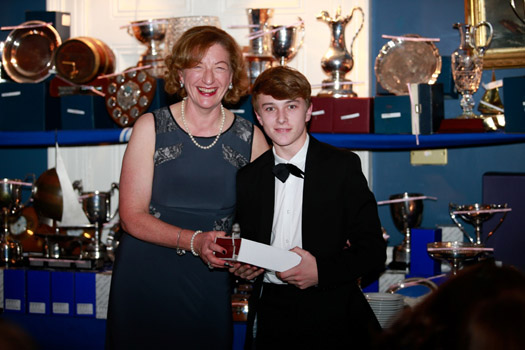
Anne-Marie Ryan presenting an award to Manx Sea Scouts for "Services Rendered" Photo: GP Foto
Earlier at the well attended ISORA AGM it was agreed to run 14 races as part of their series next season – 6 traditional cross channel races including the RORC Lyver Race and an offshore weekend that will include a Friday evening race from Holyhead to Douglas, Isle of Man and another race on the Sunday morning from Douglas to Dun Laoghaire. The Dun Laoghaire to Dingle Race will also be part of their Series. Subject to confirmation with Greystones marina it was decided that two Day races would take place simultaneously from Dun Laoghaire and Pwllheli to finish in Greystones on the day before the Greystones Regatta. This will allow those boats to partake in this new popular event. It was also decided to that the day races that start in Dun Laoghaire would not necessarily finish at the same venue but would finish in Wicklow or Howth, subject to weather conditions etc.
Other issues discussed and agreed at the AGM that ISORA would continue its practice of specifying a mandatory Safety requirement in accordance with the ISAF Offshore Special Regulations.
Shanahan's J109 Ruth Wins ISORA 2014 Championships
#isora – The National Yacht Club's top offshore yacht Ruth skippered by Liam Shanahan, that came within minutes of claiming the Round Ireland Race in June, has confirmed her overall win of the 2014 ISORA Championship following the race from Pwllheli to Dun Laoghaire yesterday. Overall results are downloadable below as a jpg file.
A J109 sistership, Mojito, won yesterday's ISORA race ten sponsored by Hendrick Ryan and Associate which featured six J boats taking the top five positions.
Overall, J109s also took the top three places with yesterday's winner the runner–up. Third was Mojito's Pwllheli club–mate Sgrech, the Stephen Tudor skippered 2013 champion.
Additional reporting by Peter Ryan below
The overall championship was decided at the last race when Liam Shanahan's "Ruth" crossed the finish line after the Hendrick Ryan + Associates "James Eadie" Pwllheli to Dun Laoghaire race on the 6th September. Fifteen boats came to the start line in Pwllheli. Of the line-up, six of the boats were "J" boats and of them five were J109's.
The forecast was for northerly winds all day ranging from 10-15 knots. At the start the wind was 10 knots and this sped the fleet down to the PSC racing Mark No 2 and then direct to Dun Laoghaire. "Jackknife" was the first to break away and was soon far out in front ahead of the five J109's. The fleet had just 2 hours to get to Bardsey or the tide would turn south against them. "Jackknife" just arrived at Bardsey as the tide was turning but the gate was firmly closed by the time the remainder of the fleet arrived. Not only that but the wind dropped.
In an effort to get out of the tide most of the boats attempted to stay as close as possible to the land side of the sound but unfortunately, there was no wind there. The lack of wind and the tide bunched the fleet, with the exception of Jackknife". The race re-started again when the winds filled in and "Mojito" led the charge out of the sound. "Predator" retired in Bardsey after storming through the stationary fleet.
The leg to Dun Laoghaire should have been a tight reach but the wind backed to the north-west and continuously veered and backed all day. All the remaining "J" boats with the exception of "Jedi", who had to retire at Bardsey, were bunched together as they headed across the Irish Sea. Seconds only separated them and there was little change in position over the remaining 57 miles.
With the winds veering and backing, the fleet just made it into Dublin Bay. "Sgrech" maintained a more northerly course and looked to be in a good position however "Mojito" managed to squeeze up and cross the finish line less than 2 minutes ahead of "Sgrech" to take the Overall and Class 1. Although "Jackknife" had finished an hour and a quarter before "Mojito", it was not enough to give them the race. "Adelie" took Class 1 while "Big Deal" took the Silver class.
"Ruth" only managed a third Overall but they did enough to take the Championship and the "Wolf's Head Trophy". They also won Class 1. "Adelie" took Class 2 while "Big Deal" took the Silver class.
The fast race meant that all boats had finished by mid-night allowing all the crews to gather in the NYC for the end of year party.
The prize giving will take place at the annual dinner in the NYC on the 15th November. The AGM will also take place that day. As normal, the race schedule for 2015 will be decided at the AGM. Suggestions for races are being sought and all should be sent to me at [email protected] . The dinner is always very popular and I would recommend that places be booked as soon as possible with the Manager in the NYC, Tim O'Brien, [email protected] .
It was the end of another great season of very mixed weather conditions. The season also produced two outstanding offshore performances by ISORA members. Liam Coyne and Brian Flahive's "Lula Belle" taking Class and 6th Overall in the recent Round Britain & Ireland Race and our new champion, Liam Shanahan and "Ruth" taking second place in the Round Ireland Race. ISORA are really proud of them.
Peter Ryan - Chairman
Round Ireland Yacht Race 2014 - The Fat Lady Sings
#roundireland14 – Can there be any ocean race of similar length that offers intrigue, excitement, drama, joy and despair to the same extent that the Round Ireland does?
What about the tight finish that saw only 7 minutes separating winner Tanit from Ruth in second place. How about Cavatina, much fancied before and after the start, on the water leader for 450 miles before fickle winds relegated her to a finish outside the top five. Think of the cruel luck of Amazing Grace, valiantly fighting back after a start line collision that cost her two hours of actual time and at least three more from missing the tide, only to break her boom when she had largely eliminated the deficit.
After recognising the great achievement of Richard Harris’ Clyde based Sydney 36 Tanit, much sympathy is reserved for Liam Shanahan and crew aboard the J109 Ruth. On Thursday morning we said “With only 45 miles to go at 4am, the forecast suggests that Ruth will enjoy a fairly steady breeze of medium strength for the final fetch to the finish.” Talk about putting the mockers on it! 4 hours later the wheels came off Ruth’s wagon and it took her 4.5 hours to cover 10 miles as the wind fell away. She still made a valiant effort to get across the line, missing out on overall honours by just 7 minutes after 5 days of racing.
Congratulations Tanit, deserved winners of the 2014 Round Ireland Yacht Race.
For those of us living the race vicariously, the Yellowbrick tracker has contributed enormously to our enjoyment so kudos to Wicklow Sailing Club and the RORC for its supply. Roll on 2016!
RoundIreland14 – It has been a classic Round Ireland Race. Just about everything except a gale, and even then there was some gear-breaking wind in the latter stages. But mostly, the sun shone. Or at least, there was little or no rain until Friday. And even if the wind didn't blow nearly enough, even those on the smaller boats who had committed a week's holiday time to this very special experience found they stayed within their leave limits, though only just.
When Wicklow farmer David Ryan confirmed in May that he had chartered the Volvo 70 Monster Project for the 2014 Round Ireland Race starting June 28th, he was succinct in his objectives. The bottom line was to support the Care For Shane campaign, which is raising funds for his nephew Shane Horgan, who was brain-damaged in a serious assault in 2012.
With the foundation of the plan in place, the details could be filled in. The Volvo 70 chosen was Russian, built in 2008 by Green Marine of Lymington. Owing to a shortage of funds during the race itself in 2008-2009, she didn't compete in all the legs. But once that race was over, here was this fine big Rob Humphreys design seeking a purpose, with time available to bring her up to standard. And she'd a new commercially-minded owner who cheerfully re-named the boat Monster Project, and worked on the basis of scouting out fresh fields for competition, as the Volvo World organisation was moving on to a new generation of boats in the next race.
But for round Ireland racing with fund-raising a priority, Monster Project ticked all the boxes. Nevertheless, Farmer Ryan was very realistic in his objectives. For sure, he hoped he might break the race's course record, which is a very different thing from the open round Ireland mono-hull record. But if he harboured even the slimmest hope of winning overall on corrected time, he kept it to himself. Yet he clearly stated that the main race objective was to win line honours – "first over the line for Shane". And at 18:25:25 hours on Wednesday July 2nd in a brisk southerly off the Wicklow pierheads with the enthusiastic support of the home crowd, Monster Project did that very thing.
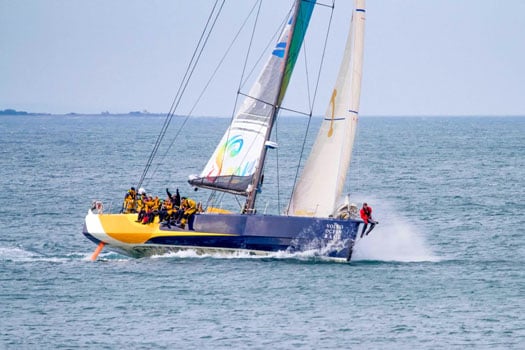
Job done. Monster Project takes line honours at Wicklow. Photo: Aidan Tarbett
As she was 70ft LOA and the next three biggest boats were "only" 60ft, it may have seemed a foregone conclusion. But the Round Ireland Race really is a case of swings and roundabouts and big dippers from time to time for every one of the 36 boats taking part. So though the Wicklow Monster may have built up a lead of 32 miles over the Open 60 Teng Tools Kilcullen (Eamon Crosbie & Enda O'Coineen) by the time she finished, she'd surely had to work for it. And had there been more fast off the wind stuff, things might have gone otherwise.
Despite the 10ft difference in length, the Open 60's potential is such that she rates an eye-watering 1.635 to the 1.6498 of Monster Project. So in rating terms the two boats were almost racing boat-for-boat, and in tactical terms that's the way Monster's 18-strong crew of all the talents had to see it.
But of course, with the predictions of light airs and calms for the first half of the week coming all too true, within 24 hours of the start it was becoming highly likely that one of the smaller boats would win, and low ratings became pearls beyond price. Observing it all and getting feedback from many sources, you became aware of the "Community of the Round Ireland Race" as the miles were slowly sailed. Their boats may have covered a wide variety of types and sizes, but the crews sharing this experience were joined together in a subtle way which gently but totally excluded outsiders.
You'd a sense of this in Wicklow as start time approached and the tension built up, with crews beginning to distance themselves from the shore crowds. Indeed, I got a blast of it in the car on the way down, listening to the Saturday morning's Down to Business programme on Newstalk, which is normally fronted by Bobby Kerr.
But as he was off to do the race on the fine big Farr 60 Newstalk for Adrenalin (chartered by Joe McDonald of the National YC), they'd a stand-in presenter. On the car radio, Kerr (a boat-owner himself) was trying to explain from the Farr 60 – with his usual zest – the special attractions of the Round Ireland Race to the American woman business journalist who was filling in for him in the studio. But he wasn't really making much progress. Her genuinely sceptical response to his enthusiasm for working coffee grinder winches and standing four hour watches 24 hours a day – and every chance of being called when you're off watch too – reminded me of the classic Bob Newhart sketch about the introduction of tobacco. The mutual incomprehension was just about total. And if Bobby Kerr can't explain the special attraction of racing round Ireland on his own radio show, then why do the rest of us even try?
The Round Ireland Race produces many imponderables. For instance, there's the matter of the new harbour and marina at Greystones finally hitting the headlines as a result of having Monster Project and Newstalk for Adrenalin based there in the leadup to the race, as Wicklow Harbour isn't really deep enough for them and both needed a pontoon berth.
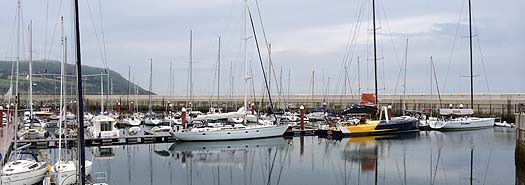
Arise, Greystones, and join the big time.....having Monster Project and Newstalk for Adrenalin in port pre-race raised Greystone's pofile something wonderful. Photo: Alan Corr
So Afloat.ie posted a pic from Alan Corr of Greystones Harbour showing the two biggies in port, and by sailing website standards it went viral. All because it's hashtagged #greystones. So be warned, in future you may find some very sleepy stories #greystones here on Afloat.ie if we hope to get them the Monster Newstalk level of attention.
But enough. Just as the sailor/spectator divide was beginning to manifest itself, I managed to get myself on board Wildwood for a quick recce. Not only was she the shortest entrant at just 30.5ft, but she was the newest with a build date of 2012. Yet in truth she was building since 2003, as this has been an extraordinary amateur design and build project, a case of good work done by stealth.
Though Wildwood sails from East Antrim Boat Club on Larne Lough, the first gleam of a notion came in the bar at Carrickfergus SC. Over a pint or three, amateur designer Richard McClure and can-do potential owner Ian Patterson sketched out ideas for a handy little dream performance cruiser-racer.
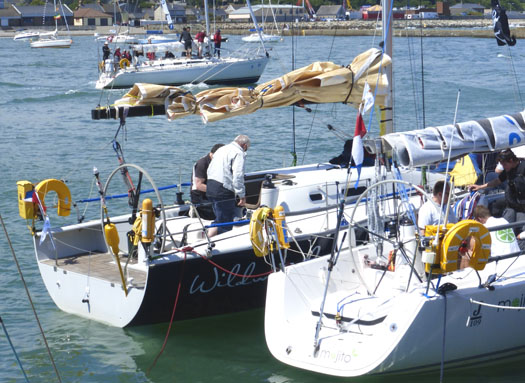
Little self-build 30-footer Wildwood (seen here outside the J/109 Mojito) came down from Larne to Wicklow for her first stab at the IRC big time. Photo: W M Nixon

Ian Patterson built Wildwood between 2003 and 2012, and they've won their class in the Scottish Three Peaks Race Photo: W M Nixon

Wildwood brought her shore support team – they came down from Larne with a couple of camper vans Photo: W M Nixon
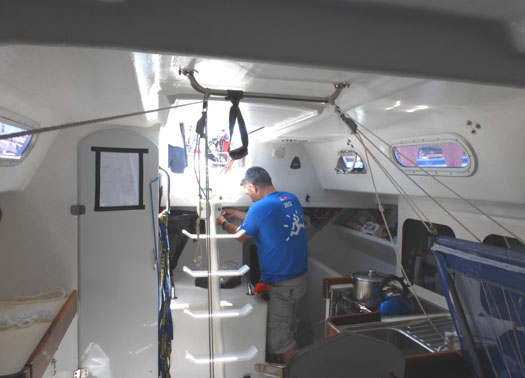
Below, Wildwood is roomy, with a highly individual layout Photo: W M Nixon

Wildwood has a substantial galley which wouldn't look out of place on a 40 footer. Photo: W M Nixon
It will be a good story to flesh out in more detail during the coming winter. Sufficient to say that she was launched in 2012 and arrived in Wicklow in June 2014 with honours already achieved by winning their class in last year's Scottish Three Peaks Race.
Nevertheless, despite the cheerful quayside support of family and friends who have stayed with the Wildwood project through its long gestation, the mood aboard was a bit subdued. The Scottish race had been on very basic handicaps, but the Round Ireland – which itself started in 1980 using a Wicklow modification of the ECHO system – is now part of the RORC programme, using strictly regulated IRC.
This new measurement routine put little Wildwood up from her notional rating of 1.02 to an official rating of 1.045. That may not seem like a huge jump, but for the crew of a little boat which prefers fast offwind stuff yet was going out to face a long beat right up Ireland's long Atlantic seaboard, it seemed like yet another mountain to climb.
But out they all go for the start, these 36 boats in all shapes and sizes, and any crewmember who denies abdominal butterflies at this time is either in denial, or so full of Stugeron they don't know what's going on below their navel.
With a decent nor'east breeze and a sluicing ebb running south, it's a tricky close reaching start at 1400 hours, but Teng Tools Kilcullen and serial overall winner Cavatina (Ian Hickey) are right there on time, and the only shunt in the body of the fleet is between western boats Lynx Clipper (Galway) and E F Collins/Amazing Grace (Tralee), with the latter returning to port to fix a fist-sized hole in her stern and set out again after some hours with a post-race protest in the offing.
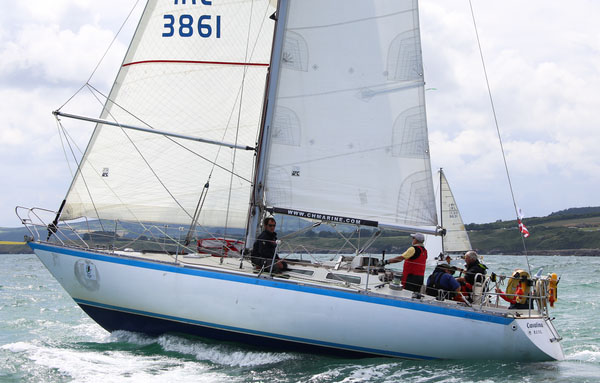
Out of the ruck of the start, the little Cavatina showed well among a raft of larger boats. Photo: David O'Brien
Coming out of the start, with boats which would emerge as performers as the race went on starting to show themselves. The Sydney 36 Tanit is left foreground, the Rodman JV 42 Phosphorus (Mark Emerson) is making hay with Code 0, the "steady Eddy" Ker 39 Inis Mor is right front, and the big Farr 60 Newstalk for Adrenalin is starting to show a performance which just kept getting better throughout the race. Photo: W M Nixon
Thanks to the Yellowbrick plotters, following the fleet has become like a computer game. If you're bored with the progress, you can always accelerate them electronically up and down along the course, with it all becoming – as the less reverent have remarked – like a pack of rats trying to get up a drainpipe.
It's when you see it reduced to symbols on a screen in the big picture that you realise how restrictive the round Ireland is for epic tactical gambles. In the Newport-Bermuda race, for instance, the 600 miles of straight line across the open ocean provides a broad canvas, and the famous Carina once notched one of her legendary wins by being all of 60 miles to the westward of the rhumb line. But in the round Ireland, only along the south coast is there a decent option for taking a real flyer, and it was there south of Youghal that Teng Tools went offshore as the wind drew sou'westerly, while the nearby and faster-to-windward Monster Project went off to close the land and cover the French Volvo 60 Libertalia and Newstalk for Adrenalin.
Monster put those two well away, but at the Fastnet she was only 20 minutes ahead of Teng Tools Kilcullen shortly after noon on Sunday, TTK coming sweetly in from seaward and doing very well in conditions which didn't really suit her at all.

Teng Tools Kilcullen at the Fastnet 21.5 hours after the start. Photo: Paul O'Flynn
In fact, if you'd set out to design a race which didn't at all suit an Open 60, then the 2014 Round Ireland would be in the top five. An awful lot of light windward work, and gates at every turn. In these conditions, a Volvo 70 is more flexible, but even so on Tuesday as Monster sat stopped off Inishtrahull, TTK was close to the southwest and energetically tacking inshore along the north coast of Donegal against a local easterly, keeping herself well in touch.
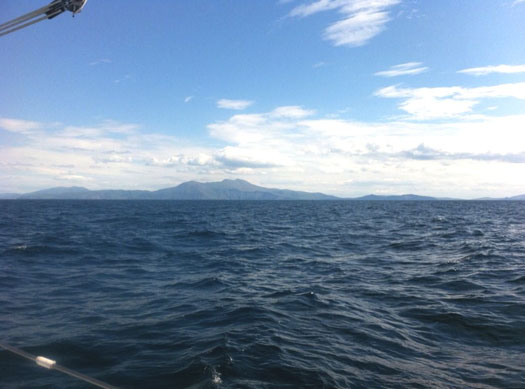
Fine day out west – the Kerry coast with the Blaskets as seen from Liam Shanahan's J/109 Ruth

Good morning, Ireland. The Scottish Sydney 36 Tanit (Richard Harris) enjoys a summer sunrise on the Atlantic coast, even if they do have to turn to windward. Photo: Roisin Harris

Even with all June's sunshine, the North Atlantic was distinctly chilly for this swim from the First 40 Arthur Logic

Downtime on the Sydney 36 Tanit out in the Atlantic. Owner Richard Harris sails under the burgee of the Serpent YC, a Scottish club founded in 1976 for sailing health professionals. Photo: Roisin Harris
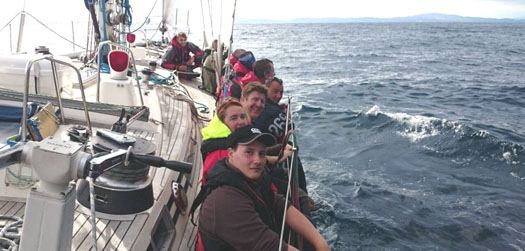
All hands to the lee rail to get a bit of heel on the hefty Swan 57 Bow Waves Racing from Galway as she makes slowly to windward off the Atlantic coast.
The two biggest boats then had an awful lot of hard work tacking through the North Channel, but astern Newstalk was getting into the groove, and by the time Monster was finishing the Farr 60 had seen off the Volvo Ocean 60, and was giving TTK a bad time.
With the new southerly filling in with gusto, the little boats still off the Donegal coast were making hay, with Cavatina coming in round Tory Island well up with the Swan 57 Bow Waves from Galway. Cavatina's crew were having the time of their lives and living well with it – they tweeted the cooking spuds which power the boat, presumably with buckets of Barry's tea. However, until Donegal the talking point had been the impressive game of catch-up being played by Brian O'Sullivan and his Tralee Bay crew in the Oyster 37 E F Collins/Amazing Grace, as they were ninth overall in IRC at one stage, and of course if their protest was upheld post-race, Heaven only knows what compensatory time would be added.
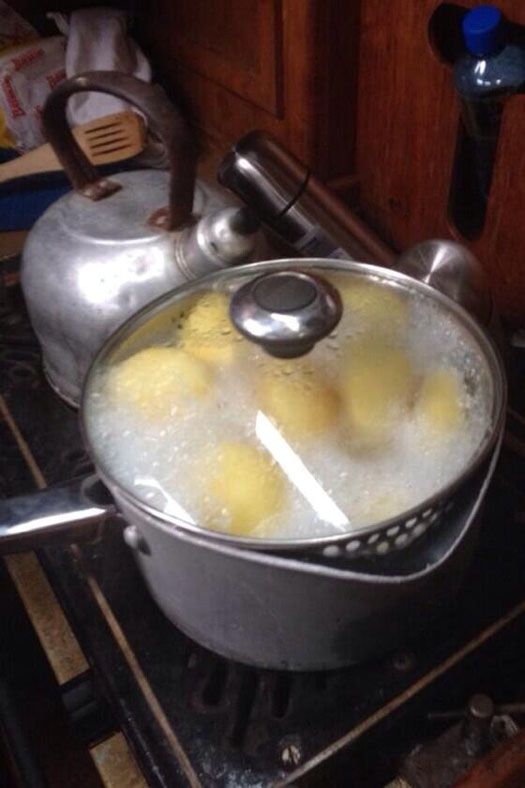
Grub up! In many years of successful Round Ireland racing, Cavatina's crew have learned the importance of feeding the inner man.
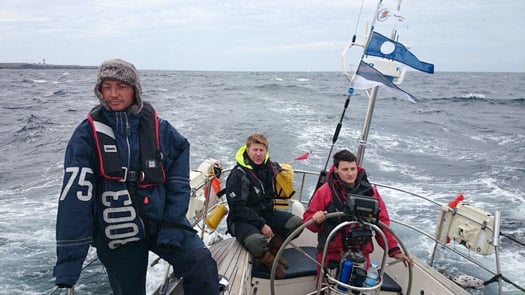
The brisk new sou'wester brought the Swan 57 Bow Waves Racing sweeping in past Tory Island, but she'd the much-smaller Cavatina in sight astern.
But that spirited performance ended with a bang on Wednesday with a broken mainboom which, together with other problems, led to their withdrawal. However, there were plenty of others to take their place in challenging for the overall lead, with Liam Shanahan and his crew from the National YC in the J/109 Ruth getting themselves firmly ahead of Frank Doyle's A 35 Endgame from Cork, while the attractive Sydney 36 Tanit from Scotland was also very much in the running.
Looking at the fleet overall as they made along the Donegal coast, there were discernible patterns emerging, with boats you'd call the "solid performers" starring on the track chart. These were boats such as Inis Mor, Tanit and Ruth which always seemed to be there or thereabouts, always plugging away and showing a clean pair of heels to the nearest-rated boats, and always well placed such that if local wind and tide conditions favoured them, they were poised to ascend rapidly to the top of the leaderboard.
As for the "sail training" vessels, in the closing stages the Jeanneau Sunfast 37 Desert Star of Irish Offshore Sailing at one stage on Wednesday found herself lying second overall to Cavatina. But with 170 miles still to go, and most of them to windward, it was going to be hard work for a keen multicultural crew of many nationalities to maintain this exalted placing.
It was Thursday morning which was crunch time. Having filled in from the south, there was a brief period in which the wind veered towards the west, and with Monster Project well finished and then Teng Tools Kilcullen, Newstalk for Adrenalin and Libertalia finishing during the night, first light saw the steady and reliable Inis Mor finishing at 04:13:56 to stake a claim which was challenged by boats such as Tanit and Ruth closing up from astern in a now-favourable tide, the tide having been against Inis Mor all the way down from Rockabill except for the last hour or so.
The challenge from a hundred miles away of Cavatina faded for a while with light airs off Belfast Lough and a foul tide in the North Channel. But in the south end of the Irish Sea and through St George's Channel, the sou'west to west breeze was holding enough to have Tanit and Ruth moving theoretically into the top slots ahead of Inis Mor. But then with the tide turning again to run north around 0900 hrs, it was to be nail biting stuff through Thursday morning.
Tanit was in by 10:00:44 hrs on Thursday, leaving the lower-rated Ruth with a mountain to climb, the tide against her and the breeze light. It was excruciating to follow, with her speed down at times to barely a knot over the ground off Greystones, and the lovely Wicklow coastline just crawling past at snail's pace. Meanwhile, far astern Cavatina was back in business with just 80 miles to sail, and a local breeze giving her better than 5 knots on the clock.
Meanwhile by 1300hrs Ruth had just 5 miles to go, and speed slowly building as the wind was generating around big clouds over Dublin.
But by just after 2pm Thursday it was clear Tanit had pipped Ruth for the clubhouse lead. Ruth had looked all set to be the leader until a cruel combination of decreasing wind and increasing adverse tide held her up within sight of the Wicklow finish. Tanit, safely in the club, knew that any setback to Ruth's progress would establish them as the target boat for the rest of the fleet. Wicklow Sailing Club could not formally announce the winner until much later on Friday as the last of the boatts finished but it was clear not even Cavatina who had until 2am on Friday could match the time of the Scottish Sydney 36.
They and all the other competitors will have this weekend to decompress and try to explain to family, friends and workmates just what this crazy Round Ireland Race thing is all about. But it isn't until the great prize giving dinner in Wicklow in the Autumn that they can all really tell the stories that just have to be told, and tell them to people who will really understand.
Thirty Enjoy Kinsale's Frostbite Finale
Conditions for the final day of the ASM-Marine Frostbite League at Kinsale Yacht Club on Sunday could not have been a more inviting finale for the thirty plus sailors competing in the Laser, Squib and Mixed Dinghy Fleets. Despite losing two of the six week series due to the weather, the last day of the season brought welcome sunshine accompanied by a fresh Force 4 North to North-Westerly breeze, gusting Force 5 at times. Three windward-leeward races were completed which brought the total race number to eleven, with two discards applying. The constantly shifting Northerly breeze, which tracked slowly westwards was the predominate feature in all three races, with an ebb tide having effect to the right hand side of the coarse.
Dara O'Shea (KYC) with another gritty performance in the Laser 4.7 fleet, managed this week to overhaul the league leader Cian Byrne (KYC/RCYC). Leaving it to the final race and with both sailors on nineteen points, Dara grasped the top spot as he fought off his rivals and eventually took line honours and the Laser 4.7 League title. Cian untypically finished fourth but nevertheless secured second place overall, just two points behind. Darragh O'Sullivan had an excellent day's racing with a win and two seconds which pulled him into third place overall, just ahead of Conor Murphy (KYC) who finished on the same points total but one place behind in the final race.
Proving once again that consistency is the key to success in the Frostbite League, Eoghan Cudmore (KYC) with a fifth, third and a second in the Radial Fleet managed to hold off the challenge for the top spot from last year's winner Sean Murphy (KYC) who scored two thirds and a fourth. With the second best results of the day, Colm O'Regan (KYC) scoring two seconds and a fourth, moved up to third place overall. Despite an excellent run of results with three wins on the final day Thomas Chaix (KYC) with insufficient points accrued could not make an impact on the final order.
In the Laser Standard Class Rob Howe (RCYC) continued his outstanding form with a further second place and two firsts bringing his overall total to an unassailable eleven points, fourteen points ahead of his nearest rival Paul O'Sullivan of Monkstown. Scoring two thirds and a second, O'Sullivan's consistent form paid off bringing him into second place overall. David Kenefick (RCYC) who had closely pursued the leader throughout the series, dropped to third place overall as he did not compete on the day.
Seldom conceding line honours Marcus Hutchinson and Ben Fusco (KYC) in the Squib Class went into the final day leading comfortably by eight points. Two wins later and a final second easily secured the league title and are now the new holders of the Bruce Mathews Squib Trophy. In a repeat of last year Paul McCarthy (KYC) finished strongly with two seconds and a win in the final race. These results elevated him from fourth place overall into the prize winning second position. Victor Fusco and Ruth Ennis (KYC) with a final third, fourth and seventh subsequently slipped one place to claim the third prize overall.
In the Mixed Dinghy Class, despite conceding line honours in all three races Brian Jones and Gary Frost (MBSC) in their International 505 finished the series as the lead boat four points comfortably ahead. The RS Feva of David Marshall and Rob Scandrett (RCYC) closed on a high note as they took advantage with three win ASM-Marine KYC Frostbite League - Sunday 27th Feb, 2011.
Conditions for the final day of the ASM-Marine Frostbite League at Kinsale Yacht Club on Sunday could not have been a more inviting finale for the thirty plus sailors competing in the Laser, Squib and Mixed Dinghy Fleets. Despite losing two of the six week series due to the weather, the last day of the season brought welcome sunshine accompanied by a fresh Force 4 North to North-Westerly breeze, gusting Force 5 at times. Three windward-leeward races were completed which brought the total race number to eleven, with two discards applying. The constantly shifting Northerly breeze, which tracked slowly westwards was the predominate feature in all three races, with an ebb tide having effect to the right hand side of the coarse.
Dara O'Shea (KYC) with another gritty performance in the Laser 4.7 fleet, managed this week to overhaul the league leader Cian Byrne (KYC/RCYC). Leaving it to the final race and with both sailors on nineteen points, Dara grasped the top spot as he fought off his rivals and eventually took line honours and the Laser 4.7 League title. Cian untypically finished fourth but nevertheless secured second place overall, just two points behind. Darragh O'Sullivan had an excellent day's racing with a win and two seconds which pulled him into third place overall, just ahead of Conor Murphy (KYC) who finished on the same points total but one place behind in the final race.
Proving once again that consistency is the key to success in the Frostbite League, Eoghan Cudmore (KYC) with a fifth, third and a second in the Radial Fleet managed to hold off the challenge for the top spot from last year's winner Sean Murphy (KYC) who scored two thirds and a fourth. With the second best results of the day, Colm O'Regan (KYC) scoring two seconds and a fourth, moved up to third place overall. Despite an excellent run of results with three wins on the final day Thomas Chaix (KYC) with insufficient points accrued could not make an impact on the final order.
In the Laser Standard Class Rob Howe (RCYC) continued his outstanding form with a further second place and two firsts bringing his overall total to an unassailable eleven points, fourteen points ahead of his nearest rival Paul O'Sullivan of Monkstown. Scoring two thirds and a second, O'Sullivan's consistent form paid off bringing him into second place overall. David Kenefick (RCYC) who had closely pursued the leader throughout the series, dropped to third place overall as he did not compete on the day.
Seldom conceding line honours Marcus Hutchinson and Ben Fusco (KYC) in the Squib Class went into the final day leading comfortably by eight points. Two wins later and a final second easily secured the league title and are now the new holders of the Bruce Mathews Squib Trophy. In a repeat of last year Paul McCarthy (KYC) finished strongly with two seconds and a win in the final race. These results elevated him from fourth place overall into the prize winning second position. Victor Fusco and Ruth Ennis (KYC) with a final third, fourth and seventh subsequently slipped one place to claim the third prize overall.
In the Mixed Dinghy Class, despite conceding line honours in all three races Brian Jones and Gary Frost (MBSC) in their International 505 finished the series as the lead boat four points comfortably ahead. The RS Feva of David Marshall and Rob Scandrett (RCYC) closed on a high note as they took advantage with three wins and claimed the second prize overall. Finishing third on the day and third overall in the series was the Feva of Fiona Lynch and Sofie Kelleher.
At the Prize Giving, Alice Kingston KYC Commodore, congratulated the deserving winners and thanked all the sailors for their efforts. Special thanks went to PRO Bruce Mathews for his dedicated support, the Organisers, the Sponsor ASM-Marine and all those who had helped both on and off the water to make this annual event such a success. Cameron Good KYC Vice-Commodore presented the prizes and June Matthews presented the Bruce Matthews Trophies for the best performances in the Laser Radial and Squib Classes won by Eoghan Cudmore and Marcus Hutchinson respectively. The inaugural Laser 4.7 'Destiny' Trophy was presented to Dara O'Shea.
- ASMMarine
- Kinsale
- yacht
- Club
- Frostbite
- Dara O'Shea
- Cian Byrne
- Darragh O'Sullivan
- Conor Murphy
- Eoghan Cudmore
- Colm O'Regan
- Sean Murphy
- Ben Fusco
- Marcus Hutchinson
- squib
- Paul McCarthy
- Ennis
- Ruth
- Dinghy
- Cameron Good
- Ruth Ennis
- Fiona Lynch
- Sofie Kelleher
- David Marshall
- Laser
- David Kenefick
- RCYC
- Royal Cork



























